tire type INFINITI QX80 2021 Warranty Information Booklet
[x] Cancel search | Manufacturer: INFINITI, Model Year: 2021, Model line: QX80, Model: INFINITI QX80 2021Pages: 54, PDF Size: 0.34 MB
Page 32 of 54
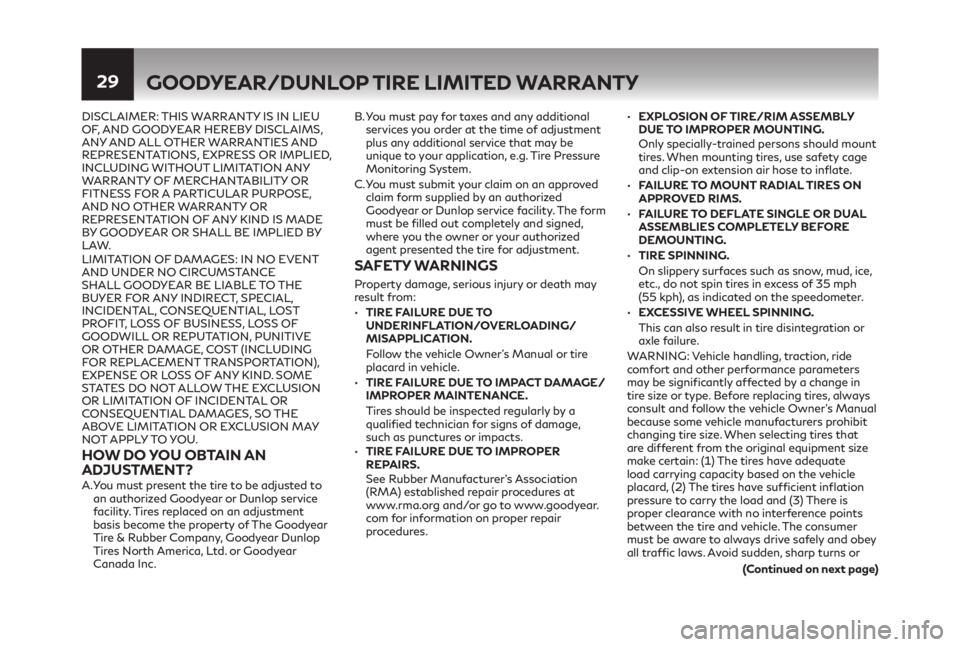
29
DISCLAIMER: THIS WARRANTY IS IN LIEU
OF, AND GOODYEAR HEREBY DISCLAIMS,
ANY AND ALL OTHER WARRANTIES AND
REPRESENTATIONS, EXPRESS OR IMPLIED,
INCLUDING WITHOUT LIMITATION ANY
WARRANTY OF MERCHANTABILITY OR
FITNESS FOR A PARTICULAR PURPOSE,
AND NO OTHER WARRANTY OR
REPRESENTATION OF ANY KIND IS MADE
BY GOODYEAR OR SHALL BE IMPLIED BY
L AW.
LIMITATION OF DAMAGES: IN NO EVENT
AND UNDER NO CIRCUMSTANCE
SHALL GOODYEAR BE LIABLE TO THE
BUYER FOR ANY INDIRECT, SPECIAL,
INCIDENTAL, CONSEQUENTIAL, LOST
PROFIT, LOSS OF BUSINESS, LOSS OF
GOODWILL OR REPUTATION, PUNITIVE
OR OTHER DAMAGE, COST (INCLUDING
FOR REPLACEMENT TRANSPORTATION),
EXPENSE OR LOSS OF ANY KIND. SOME
STATES DO NOT ALLOW THE EXCLUSION
OR LIMITATION OF INCIDENTAL OR
CONSEQUENTIAL DAMAGES, SO THE
ABOVE LIMITATION OR EXCLUSION MAY
NOT APPLY TO YOU.
HOW DO YOU OBTAIN AN
ADJUSTMENT?
A. You must present the tire to be adjusted to
an authorized Goodyear or Dunlop service
facility. Tires replaced on an adjustment
basis become the property of The Goodyear
Tire & Rubber Company, Goodyear Dunlop
Tires North America, Ltd. or Goodyear
Canada Inc. B.
You must pay for taxes and any additional
services you order at the time of adjustment
plus any additional service that may be
unique to your application, e.g. Tire Pressure
Monitoring System.
C. You must submit your claim on an approved
claim form supplied by an authorized
Goodyear or Dunlop service facility. The form
must be filled out completely and signed,
where you the owner or your authorized
agent presented the tire for adjustment.
SAFETY WARNINGS
Property damage, serious injury or death may
result from:
•• TIRE FAILURE DUE TO
UNDERINFLATION/OVERLOADING/
MISAPPLICATION.
Follow the vehicle Owner’s Manual or tire
placard in vehicle.
•• TIRE FAILURE DUE TO IMPACT DAMAGE/
IMPROPER MAINTENANCE.
Tires should be inspected regularly by a
qualified technician for signs of damage,
such as punctures or impacts.
•• TIRE FAILURE DUE TO IMPROPER
REPAIRS.
See Rubber Manufacturer’s Association
(RMA) established repair procedures at
www.rma.org and/or go to www.goodyear.
com for information on proper repair
procedures.
•• EXPLOSION OF TIRE/RIM ASSEMBLY
DUE TO IMPROPER MOUNTING.
Only specially-trained persons should mount
tires. When mounting tires, use safety cage
and clip-on extension air hose to inflate.
•• FAILURE TO MOUNT RADIAL TIRES ON
APPROVED RIMS.
•• FAILURE TO DEFLATE SINGLE OR DUAL
ASSEMBLIES COMPLETELY BEFORE
DEMOUNTING.
•• TIRE SPINNING.
On slippery surfaces such as snow, mud, ice,
etc., do not spin tires in excess of 35 mph
(55 kph), as indicated on the speedometer.
•• EXCESSIVE WHEEL SPINNING.
This can also result in tire disintegration or
axle failure.
WARNING: Vehicle handling, traction, ride
comfort and other performance parameters
may be significantly affected by a change in
tire size or type. Before replacing tires, always
consult and follow the vehicle Owner’s Manual
because some vehicle manufacturers prohibit
changing tire size. When selecting tires that
are different from the original equipment size
make certain: (1) The tires have adequate
load carrying capacity based on the vehicle
placard, (2) The tires have sufficient inflation
pressure to carry the load and (3) There is
proper clearance with no interference points
between the tire and vehicle. The consumer
must be aware to always drive safely and obey
all traffic laws. Avoid sudden, sharp turns or
GOODYEAR/DUNLOP TIRE LIMITED WARRANTY
(Continued on next page)
4303458_21a_INFINITI_US_WIB_032520.indd 294303458_21a_INFINITI_US_WIB_032520.indd 294/8/2020 10:18:18 AM4/8/2020 10:18:18 AM
Page 33 of 54
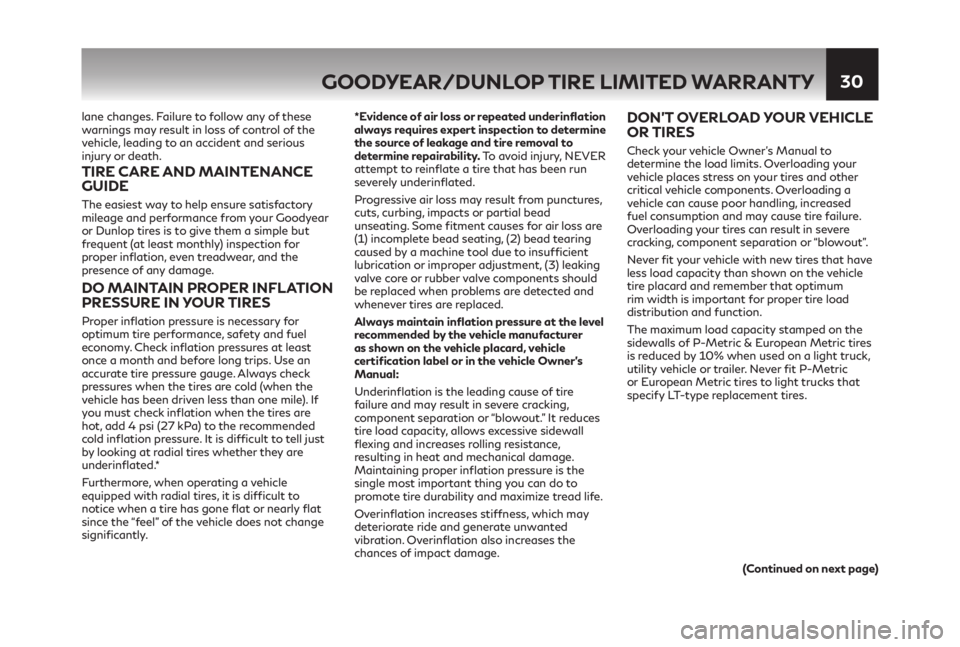
30
lane changes. Failure to follow any of these
warnings may result in loss of control of the
vehicle, leading to an accident and serious
injury or death.
TIRE CARE AND MAINTENANCE
GUIDE
The easiest way to help ensure satisfactory
mileage and performance from your Goodyear
or Dunlop tires is to give them a simple but
frequent (at least monthly) inspection for
proper inflation, even treadwear, and the
presence of any damage.
DO MAINTAIN PROPER INFLATION
PRESSURE IN YOUR TIRES
Proper inflation pressure is necessary for
optimum tire performance, safety and fuel
economy. Check inflation pressures at least
once a month and before long trips. Use an
accurate tire pressure gauge. Always check
pressures when the tires are cold (when the
vehicle has been driven less than one mile). If
you must check inflation when the tires are
hot, add 4 psi (27 kPa) to the recommended
cold inflation pressure. It is difficult to tell just
by looking at radial tires whether they are
underinflated.*
Furthermore, when operating a vehicle
equipped with radial tires, it is difficult to
notice when a tire has gone flat or nearly flat
since the “feel” of the vehicle does not change
significantly. *Evidence of air loss or repeated underinflation
always requires expert inspection to determine
the source of leakage and tire removal to
determine repairability. To avoid injury, NEVER
attempt to reinflate a tire that has been run
severely underinflated.
Progressive air loss may result from punctures,
cuts, curbing, impacts or partial bead
unseating. Some fitment causes for air loss are
(1) incomplete bead seating, (2) bead tearing
caused by a machine tool due to insufficient
lubrication or improper adjustment, (3) leaking
valve core or rubber valve components should
be replaced when problems are detected and
whenever tires are replaced.
Always maintain inflation pressure at the level
recommended by the vehicle manufacturer
as shown on the vehicle placard, vehicle
certification label or in the vehicle Owner’s
Manual:
Underinflation is the leading cause of tire
failure and may result in severe cracking,
component separation or “blowout.” It reduces
tire load capacity, allows excessive sidewall
flexing and increases rolling resistance,
resulting in heat and mechanical damage.
Maintaining proper inflation pressure is the
single most important thing you can do to
promote tire durability and maximize tread life.
Overinflation increases stiffness, which may
deteriorate ride and generate unwanted
vibration. Overinflation also increases the
chances of impact damage.
DON’T OVERLOAD YOUR VEHICLE
OR TIRES
Check your vehicle Owner’s Manual to
determine the load limits. Overloading your
vehicle places stress on your tires and other
critical vehicle components. Overloading a
vehicle can cause poor handling, increased
fuel consumption and may cause tire failure.
Overloading your tires can result in severe
cracking, component separation or “blowout”.
Never fit your vehicle with new tires that have
less load capacity than shown on the vehicle
tire placard and remember that optimum
rim width is important for proper tire load
distribution and function.
The maximum load capacity stamped on the
sidewalls of P-Metric & European Metric tires
is reduced by 10% when used on a light truck,
utility vehicle or trailer. Never fit P-Metric
or European Metric tires to light trucks that
specify LT-type replacement tires.
(Continued on next page)
GOODYEAR/DUNLOP TIRE LIMITED WARRANTY
4303458_21a_INFINITI_US_WIB_032520.indd 304303458_21a_INFINITI_US_WIB_032520.indd 304/8/2020 10:18:18 AM4/8/2020 10:18:18 AM
Page 34 of 54
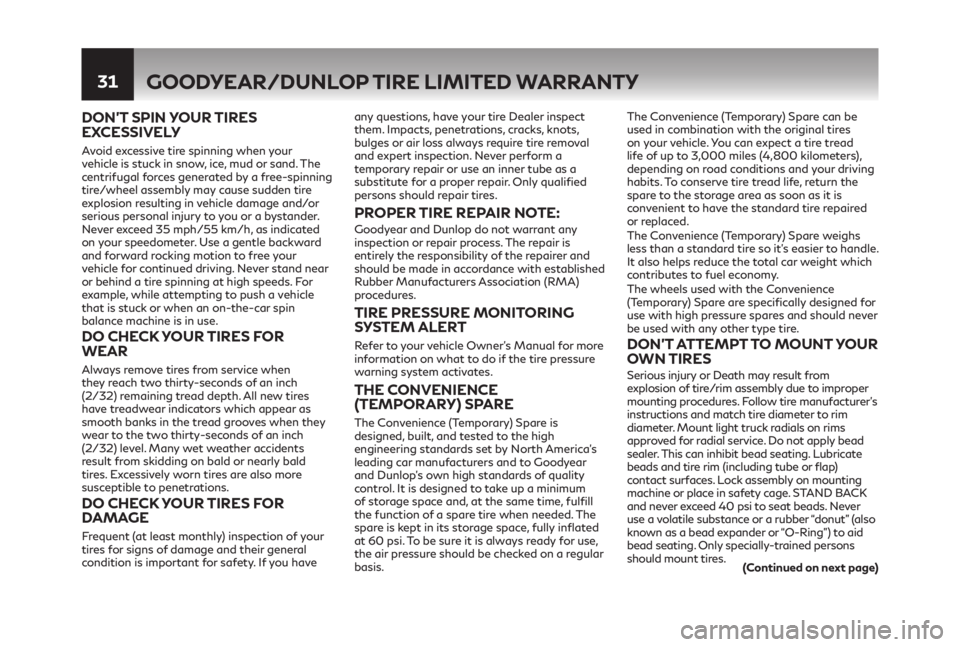
31
DON’T SPIN YOUR TIRES
EXCESSIVELY
Avoid excessive tire spinning when your
vehicle is stuck in snow, ice, mud or sand. The
centrifugal forces generated by a free-spinning
tire/wheel assembly may cause sudden tire
explosion resulting in vehicle damage and/or
serious personal injury to you or a bystander.
Never exceed 35 mph/55 km/h, as indicated
on your speedometer. Use a gentle backward
and forward rocking motion to free your
vehicle for continued driving. Never stand near
or behind a tire spinning at high speeds. For
example, while attempting to push a vehicle
that is stuck or when an on-the-car spin
balance machine is in use.
DO CHECK YOUR TIRES FOR
WEAR
Always remove tires from service when
they reach two thirty-seconds of an inch
(2/32) remaining tread depth. All new tires
have treadwear indicators which appear as
smooth banks in the tread grooves when they
wear to the two thirty-seconds of an inch
(2/32) level. Many wet weather accidents
result from skidding on bald or nearly bald
tires. Excessively worn tires are also more
susceptible to penetrations.
DO CHECK YOUR TIRES FOR
DAMAGE
Frequent (at least monthly) inspection of your
tires for signs of damage and their general
condition is important for safety. If you have any questions, have your tire Dealer inspect
them. Impacts, penetrations, cracks, knots,
bulges or air loss always require tire removal
and expert inspection. Never perform a
temporary repair or use an inner tube as a
substitute for a proper repair. Only qualified
persons should repair tires.
PROPER TIRE REPAIR NOTE:
Goodyear and Dunlop do not warrant any
inspection or repair process. The repair is
entirely the responsibility of the repairer and
should be made in accordance with established
Rubber Manufacturers Association (RMA)
procedures.
TIRE PRESSURE MONITORING
SYSTEM ALERT
Refer to your vehicle Owner’s Manual for more
information on what to do if the tire pressure
warning system activates.
THE CONVENIENCE
(TEMPORARY) SPARE
The Convenience (Temporary) Spare is
designed, built, and tested to the high
engineering standards set by North America’s
leading car manufacturers and to Goodyear
and Dunlop’s own high standards of quality
control. It is designed to take up a minimum
of storage space and, at the same time, fulfill
the function of a spare tire when needed. The
spare is kept in its storage space, fully inflated
at 60 psi. To be sure it is always ready for use,
the air pressure should be checked on a regular
basis. The Convenience (Temporary) Spare can be
used in combination with the original tires
on your vehicle. You can expect a tire tread
life of up to 3,000 miles (4,800 kilometers),
depending on road conditions and your driving
habits. To conserve tire tread life, return the
spare to the storage area as soon as it is
convenient to have the standard tire repaired
or replaced.
The Convenience (Temporary) Spare weighs
less than a standard tire so it’s easier to handle.
It also helps reduce the total car weight which
contributes to fuel economy.
The wheels used with the Convenience
(Temporary) Spare are specifically designed for
use with high pressure spares and should never
be used with any other type tire.
DON’T ATTEMPT TO MOUNT YOUR
OWN TIRES
Serious injury or Death may result from
explosion of tire/rim assembly due to improper
mounting procedures. Follow tire manufacturer’s
instructions and match tire diameter to rim
diameter. Mount light truck radials on rims
approved for radial service. Do not apply bead
sealer. This can inhibit bead seating. Lubricate
beads and tire rim (including tube or flap)
contact surfaces. Lock assembly on mounting
machine or place in safety cage. STAND BACK
and never exceed 40 psi to seat beads. Never
use a volatile substance or a rubber “donut” (also
known as a bead expander or “O-Ring”) to aid
bead seating. Only specially-trained persons
should mount tires.
GOODYEAR/DUNLOP TIRE LIMITED WARRANTY
(Continued on next page)
4303458_21a_INFINITI_US_WIB_032520.indd 314303458_21a_INFINITI_US_WIB_032520.indd 314/8/2020 10:18:18 AM4/8/2020 10:18:18 AM
Page 35 of 54
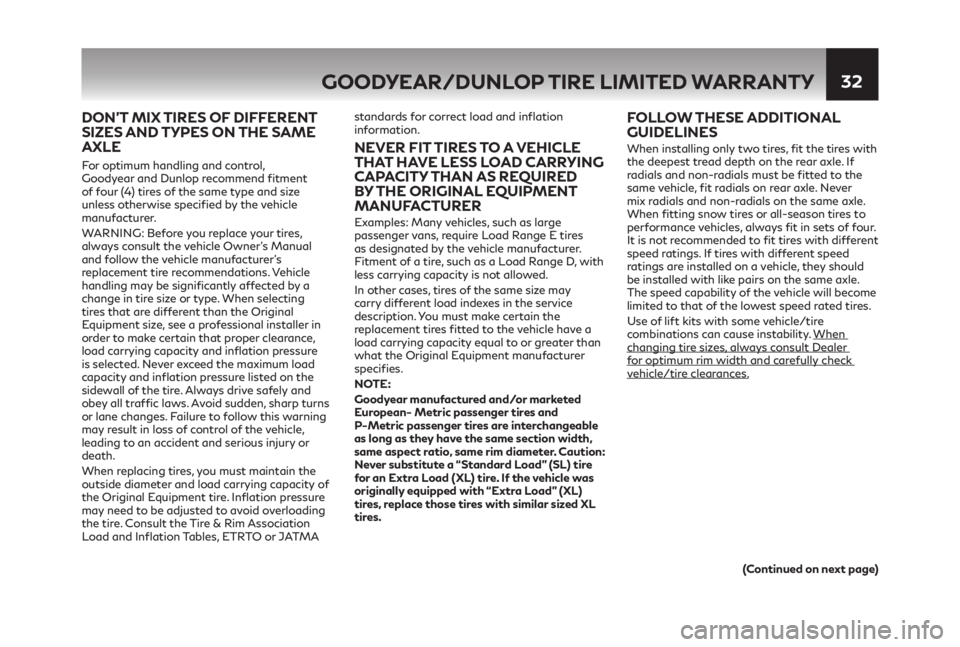
32
DON’T MIX TIRES OF DIFFERENT
SIZES AND TYPES ON THE SAME
AXLE
For optimum handling and control,
Goodyear and Dunlop recommend fitment
of four (4) tires of the same type and size
unless otherwise specified by the vehicle
manufacturer.
WARNING: Before you replace your tires,
always consult the vehicle Owner’s Manual
and follow the vehicle manufacturer’s
replacement tire recommendations. Vehicle
handling may be significantly affected by a
change in tire size or type. When selecting
tires that are different than the Original
Equipment size, see a professional installer in
order to make certain that proper clearance,
load carrying capacity and inflation pressure
is selected. Never exceed the maximum load
capacity and inflation pressure listed on the
sidewall of the tire. Always drive safely and
obey all traffic laws. Avoid sudden, sharp turns
or lane changes. Failure to follow this warning
may result in loss of control of the vehicle,
leading to an accident and serious injury or
death.
When replacing tires, you must maintain the
outside diameter and load carrying capacity of
the Original Equipment tire. Inflation pressure
may need to be adjusted to avoid overloading
the tire. Consult the Tire & Rim Association
Load and Inflation Tables, ETRTO or JATMA standards for correct load and inflation
information.
NEVER FIT TIRES TO A VEHICLE
THAT HAVE LESS LOAD CARRYING
CAPACITY THAN AS REQUIRED
BY THE ORIGINAL EQUIPMENT
MANUFACTURER
Examples: Many vehicles, such as large
passenger vans, require Load Range E tires
as designated by the vehicle manufacturer.
Fitment of a tire, such as a Load Range D, with
less carrying capacity is not allowed.
In other cases, tires of the same size may
carry different load indexes in the service
description. You must make certain the
replacement tires fitted to the vehicle have a
load carrying capacity equal to or greater than
what the Original Equipment manufacturer
specifies.
NOTE:
Goodyear manufactured and/or marketed
European- Metric passenger tires and
P-Metric passenger tires are interchangeable
as long as they have the same section width,
same aspect ratio, same rim diameter. Caution:
Never substitute a “Standard Load” (SL) tire
for an Extra Load (XL) tire. If the vehicle was
originally equipped with “Extra Load” (XL)
tires, replace those tires with similar sized XL
tires.
FOLLOW THESE ADDITIONAL
GUIDELINES
When installing only two tires, fit the tires with
the deepest tread depth on the rear axle. If
radials and non-radials must be fitted to the
same vehicle, fit radials on rear axle. Never
mix radials and non-radials on the same axle.
When fitting snow tires or all-season tires to
performance vehicles, always fit in sets of four.
It is not recommended to fit tires with different
speed ratings. If tires with different speed
ratings are installed on a vehicle, they should
be installed with like pairs on the same axle.
The speed capability of the vehicle will become
limited to that of the lowest speed rated tires.
Use of lift kits with some vehicle/tire
combinations can cause instability. When
changing tire sizes, always consult Dealer
for optimum rim width and carefully check
vehicle/tire clearances.
GOODYEAR/DUNLOP TIRE LIMITED WARRANTY
(Continued on next page)
4303458_21a_INFINITI_US_WIB_032520.indd 324303458_21a_INFINITI_US_WIB_032520.indd 324/8/2020 10:18:18 AM4/8/2020 10:18:18 AM
Page 46 of 54
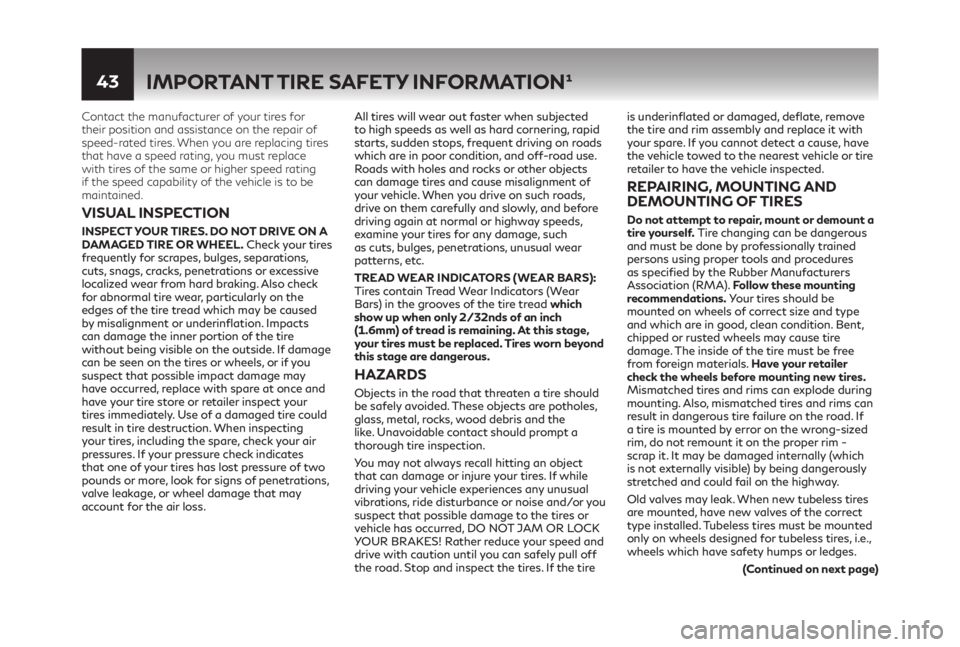
43
Contact the manufacturer of your tires for
their position and assistance on the repair of
speed-rated tires. When you are replacing tires
that have a speed rating, you must replace
with tires of the same or higher speed rating
if the speed capability of the vehicle is to be
maintained.
VISUAL INSPECTION
INSPECT YOUR TIRES. DO NOT DRIVE ON A
DAMAGED TIRE OR WHEEL. Check your tires
frequently for scrapes, bulges, separations,
cuts, snags, cracks, penetrations or excessive
localized wear from hard braking. Also check
for abnormal tire wear, particularly on the
edges of the tire tread which may be caused
by misalignment or underinflation. Impacts
can damage the inner portion of the tire
without being visible on the outside. If damage
can be seen on the tires or wheels, or if you
suspect that possible impact damage may
have occurred, replace with spare at once and
have your tire store or retailer inspect your
tires immediately. Use of a damaged tire could
result in tire destruction. When inspecting
your tires, including the spare, check your air
pressures. If your pressure check indicates
that one of your tires has lost pressure of two
pounds or more, look for signs of penetrations,
valve leakage, or wheel damage that may
account for the air loss. All tires will wear out faster when subjected
to high speeds as well as hard cornering, rapid
starts, sudden stops, frequent driving on roads
which are in poor condition, and off-road use.
Roads with holes and rocks or other objects
can damage tires and cause misalignment of
your vehicle. When you drive on such roads,
drive on them carefully and slowly, and before
driving again at normal or highway speeds,
examine your tires for any damage, such
as cuts, bulges, penetrations, unusual wear
patterns, etc.
TREAD WEAR INDICATORS (WEAR BARS):
Tires contain Tread Wear Indicators (Wear
Bars) in the grooves of the tire tread which
show up when only 2/32nds of an inch
(1.6mm) of tread is remaining. At this stage,
your tires must be replaced. Tires worn beyond
this stage are dangerous.
HAZARDS
Objects in the road that threaten a tire should
be safely avoided. These objects are potholes,
glass, metal, rocks, wood debris and the
like. Unavoidable contact should prompt a
thorough tire inspection.
You may not always recall hitting an object
that can damage or injure your tires. If while
driving your vehicle experiences any unusual
vibrations, ride disturbance or noise and/or you
suspect that possible damage to the tires or
vehicle has occurred, DO NOT JAM OR LOCK
YOUR BRAKES! Rather reduce your speed and
drive with caution until you can safely pull off
the road. Stop and inspect the tires. If the tire is underinflated or damaged, deflate, remove
the tire and rim assembly and replace it with
your spare. If you cannot detect a cause, have
the vehicle towed to the nearest vehicle or tire
retailer to have the vehicle inspected.
REPAIRING, MOUNTING AND
DEMOUNTING OF TIRES
Do not attempt to repair, mount or demount a
tire yourself. Tire changing can be dangerous
and must be done by professionally trained
persons using proper tools and procedures
as specified by the Rubber Manufacturers
Association (RMA). Follow these mounting
recommendations. Your tires should be
mounted on wheels of correct size and type
and which are in good, clean condition. Bent,
chipped or rusted wheels may cause tire
damage. The inside of the tire must be free
from foreign materials. Have your retailer
check the wheels before mounting new tires.
Mismatched tires and rims can explode during
mounting. Also, mismatched tires and rims can
result in dangerous tire failure on the road. If
a tire is mounted by error on the wrong-sized
rim, do not remount it on the proper rim -
scrap it. It may be damaged internally (which
is not externally visible) by being dangerously
stretched and could fail on the highway.
Old valves may leak. When new tubeless tires
are mounted, have new valves of the correct
type installed. Tubeless tires must be mounted
only on wheels designed for tubeless tires, i.e.,
wheels which have safety humps or ledges.
IMPORTANT TIRE SAFETY INFORMATION¹
(Continued on next page)
4303458_21a_INFINITI_US_WIB_032520.indd 434303458_21a_INFINITI_US_WIB_032520.indd 434/8/2020 10:18:18 AM4/8/2020 10:18:18 AM
Page 48 of 54
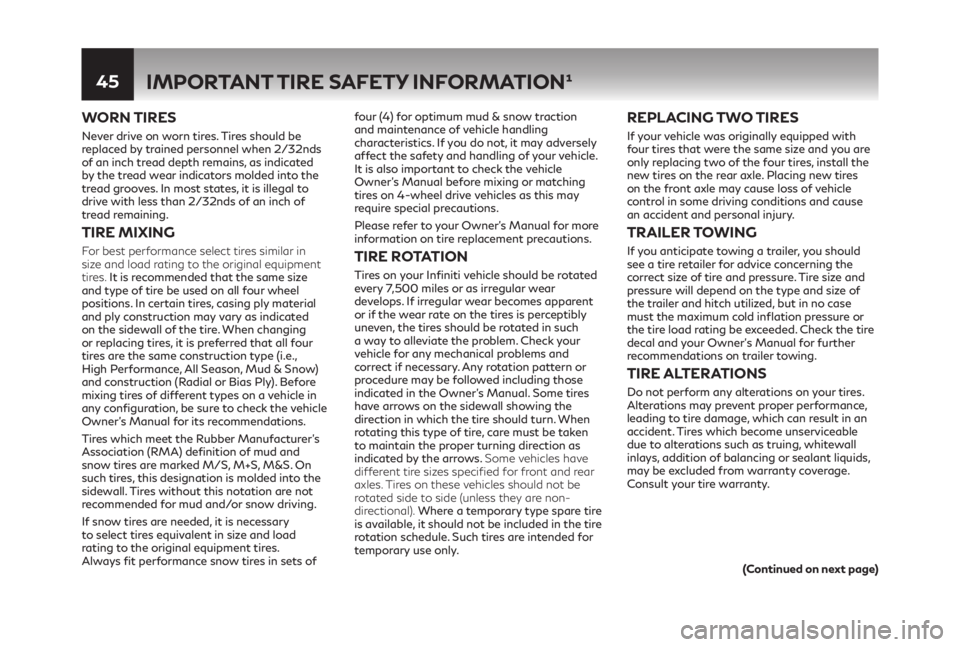
45
WORN TIRES
Never drive on worn tires. Tires should be
replaced by trained personnel when 2/32nds
of an inch tread depth remains, as indicated
by the tread wear indicators molded into the
tread grooves. In most states, it is illegal to
drive with less than 2/32nds of an inch of
tread remaining.
TIRE MIXING
For best performance select tires similar in
size and load rating to the original equipment
tires. It is recommended that the same size
and type of tire be used on all four wheel
positions. In certain tires, casing ply material
and ply construction may vary as indicated
on the sidewall of the tire. When changing
or replacing tires, it is preferred that all four
tires are the same construction type (i.e.,
High Performance, All Season, Mud & Snow)
and construction (Radial or Bias Ply). Before
mixing tires of different types on a vehicle in
any configuration, be sure to check the vehicle
Owner’s Manual for its recommendations.
Tires which meet the Rubber Manufacturer’s
Association (RMA) definition of mud and
snow tires are marked M/S, M+S, M&S. On
such tires, this designation is molded into the
sidewall. Tires without this notation are not
recommended for mud and/or snow driving.
If snow tires are needed, it is necessary
to select tires equivalent in size and load
rating to the original equipment tires.
Always fit performance snow tires in sets of four (4) for optimum mud & snow traction
and maintenance of vehicle handling
characteristics. If you do not, it may adversely
affect the safety and handling of your vehicle.
It is also important to check the vehicle
Owner’s Manual before mixing or matching
tires on 4-wheel drive vehicles as this may
require special precautions.
Please refer to your Owner’s Manual for more
information on tire replacement precautions. TIRE ROTATION
Tires on your Infiniti vehicle should be rotated
every 7,500 miles or as irregular wear
develops. If irregular wear becomes apparent
or if the wear rate on the tires is perceptibly
uneven, the tires should be rotated in such
a way to alleviate the problem. Check your
vehicle for any mechanical problems and
correct if necessary. Any rotation pattern or
procedure may be followed including those
indicated in the Owner’s Manual. Some tires
have arrows on the sidewall showing the
direction in which the tire should turn. When
rotating this type of tire, care must be taken
to maintain the proper turning direction as
indicated by the arrows. Some vehicles have
different tire sizes specified for front and rear
axles. Tires on these vehicles should not be
rotated side to side (unless they are non-
directional). Where a temporary type spare tire
is available, it should not be included in the tire
rotation schedule. Such tires are intended for
temporary use only.
REPLACING TWO TIRES
If your vehicle was originally equipped with
four tires that were the same size and you are
only replacing two of the four tires, install the
new tires on the rear axle. Placing new tires
on the front axle may cause loss of vehicle
control in some driving conditions and cause
an accident and personal injury.
TRAILER TOWING
If you anticipate towing a trailer, you should
see a tire retailer for advice concerning the
correct size of tire and pressure. Tire size and
pressure will depend on the type and size of
the trailer and hitch utilized, but in no case
must the maximum cold inflation pressure or
the tire load rating be exceeded. Check the tire
decal and your Owner’s Manual for further
recommendations on trailer towing.
TIRE ALTERATIONS
Do not perform any alterations on your tires.
Alterations may prevent proper performance,
leading to tire damage, which can result in an
accident. Tires which become unserviceable
due to alterations such as truing, whitewall
inlays, addition of balancing or sealant liquids,
may be excluded from warranty coverage.
Consult your tire warranty.
(Continued on next page)
IMPORTANT TIRE SAFETY INFORMATION¹
4303458_21a_INFINITI_US_WIB_032520.indd 454303458_21a_INFINITI_US_WIB_032520.indd 454/8/2020 10:18:19 AM4/8/2020 10:18:19 AM
Page 49 of 54
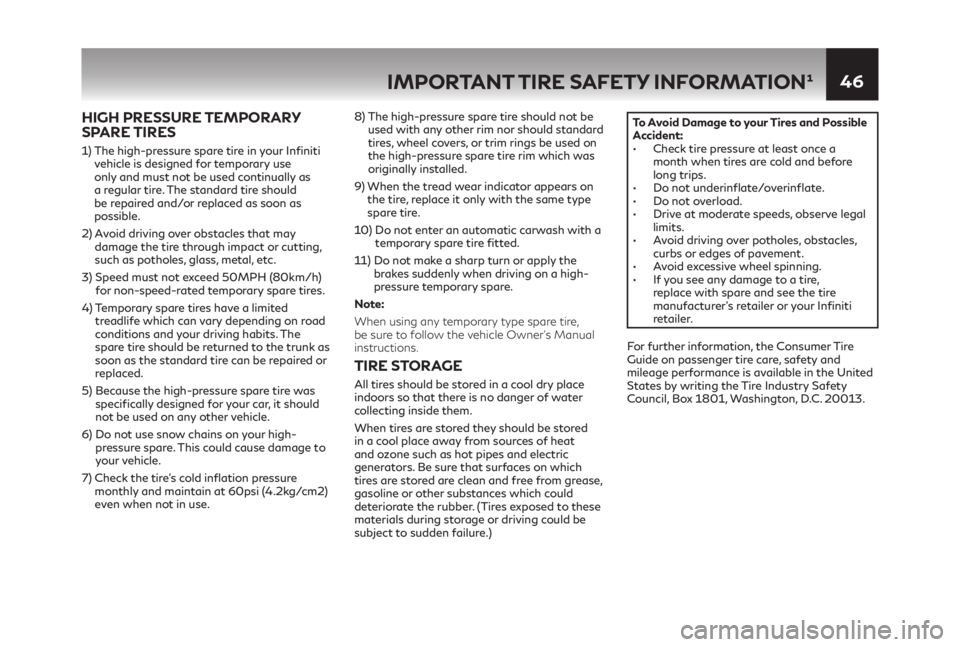
46
HIGH PRESSURE TEMPORARY
SPARE TIRES
1)
The high-pressure spare tire in your Infiniti
vehicle is designed for temporary use
only and must not be used continually as
a regular tire. The standard tire should
be repaired and/or replaced as soon as
possible.
2)
Avoid driving over obstacles that may
damage the tire through impact or cutting,
such as potholes, glass, metal, etc.
3) Speed must not exceed 50MPH (80km/h)
for non-speed-rated temporary spare tires.
4)
Temporary spare tires have a limited
treadlife which can vary depending on road
conditions and your driving habits. The
spare tire should be returned to the trunk as
soon as the standard tire can be repaired or
replaced.
5) Because the high-pressure spare tire was
specifically designed for your car, it should
not be used on any other vehicle.
6) Do not use snow chains on your high-
pressure spare. This could cause damage to
your vehicle.
7) Check the tire’s cold inflation pressure
monthly and maintain at 60psi (4.2kg/cm2)
even when not in use. 8)
The high-pressure spare tire should not be
used with any other rim nor should standard
tires, wheel covers, or trim rings be used on
the high-pressure spare tire rim which was
originally installed.
9)
When the tread wear indicator appears on
the tire, replace it only with the same type
spare tire.
10) Do not enter an automatic carwash with a
temporary spare tire fitted.
11) Do not make a sharp turn or apply the
brakes suddenly when driving on a high-
pressure temporary spare.
Note:
When using any temporary type spare tire,
be sure to follow the vehicle Owner’s Manual
instructions.
TIRE STORAGE
All tires should be stored in a cool dry place
indoors so that there is no danger of water
collecting inside them.
When tires are stored they should be stored
in a cool place away from sources of heat
and ozone such as hot pipes and electric
generators. Be sure that surfaces on which
tires are stored are clean and free from grease,
gasoline or other substances which could
deteriorate the rubber. (Tires exposed to these
materials during storage or driving could be
subject to sudden failure.) To Avoid Damage to your Tires and Possible
Accident:
•• Check tire pressure at least once a
month when tires are cold and before
long trips.
•• Do not underinflate/overinflate.•• Do not overload.•• Drive at moderate speeds, observe legal
limits.
•• Avoid driving over potholes, obstacles,
curbs or edges of pavement.
•• Avoid excessive wheel spinning.•• If you see any damage to a tire,
replace with spare and see the tire
manufacturer’s retailer or your Infiniti
retailer.
For further information, the Consumer Tire
Guide on passenger tire care, safety and
mileage performance is available in the United
States by writing the Tire Industry Safety
Council, Box 1801, Washington, D.C. 20013.
IMPORTANT TIRE SAFETY INFORMATION¹
4303458_21a_INFINITI_US_WIB_032520.indd 464303458_21a_INFINITI_US_WIB_032520.indd 464/8/2020 10:18:19 AM4/8/2020 10:18:19 AM
Page 50 of 54
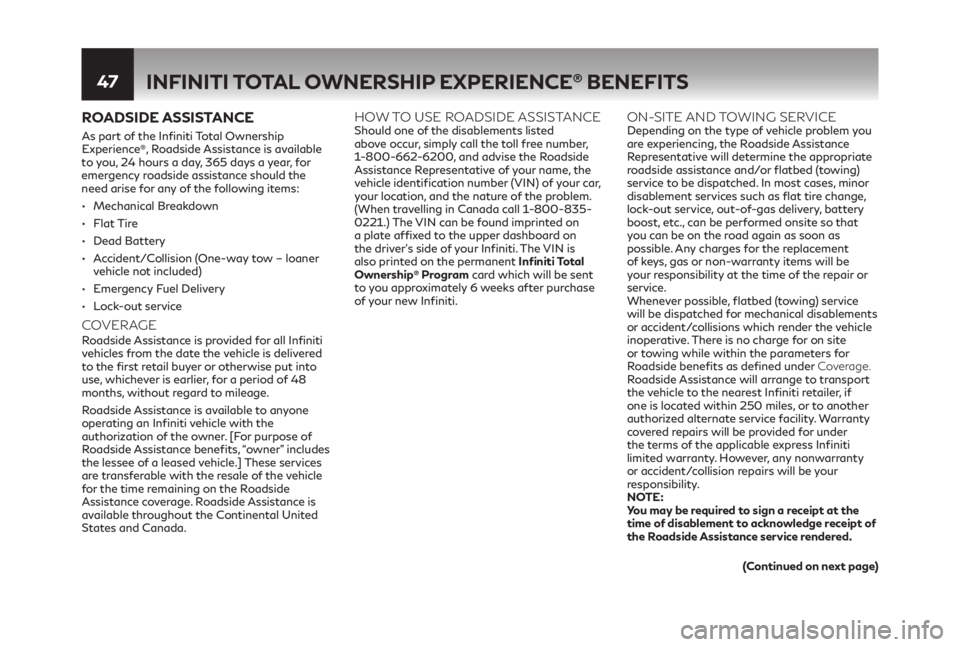
47INFINITI TOTAL OWNERSHIP EXPERIENCE® BENEFITS
ROADSIDE ASSISTANCE
As part of the Infiniti Total Ownership
Experience®, Roadside Assistance is available
to you, 24 hours a day, 365 days a year, for
emergency roadside assistance should the
need arise for any of the following items:
•• Mechanical Breakdown
•• Flat Tire
•• Dead Battery
•• Accident/Collision (One-way tow – loaner
vehicle not included)
•• Emergency Fuel Delivery
•• Lock-out service
COVERAGE Roadside Assistance is provided for all Infiniti
vehicles from the date the vehicle is delivered
to the first retail buyer or otherwise put into
use, whichever is earlier, for a period of 48
months, without regard to mileage.
Roadside Assistance is available to anyone
operating an Infiniti vehicle with the
authorization of the owner. [For purpose of
Roadside Assistance benefits, “owner” includes
the lessee of a leased vehicle.] These services
are transferable with the resale of the vehicle
for the time remaining on the Roadside
Assistance coverage. Roadside Assistance is
available throughout the Continental United
States and Canada.
HOW TO USE ROADSIDE ASSISTANCE Should one of the disablements listed
above occur, simply call the toll free number,
1-800-662-6200, and advise the Roadside
Assistance Representative of your name, the
vehicle identification number (VIN) of your car,
your location, and the nature of the problem.
(When travelling in Canada call 1-800-835-
0221.) The VIN can be found imprinted on
a plate affixed to the upper dashboard on
the driver’s side of your Infiniti. The VIN is
also printed on the permanent Infiniti Total
Ownership
® Program card which will be sent
to you approximately 6 weeks after purchase
of your new Infiniti.
ON-SITE AND TOWING SERVICE Depending on the type of vehicle problem you
are experiencing, the Roadside Assistance
Representative will determine the appropriate
roadside assistance and/or flatbed (towing)
service to be dispatched. In most cases, minor
disablement services such as flat tire change,
lock-out service, out-of-gas delivery, battery
boost, etc., can be performed onsite so that
you can be on the road again as soon as
possible. Any charges for the replacement
of keys, gas or non-warranty items will be
your responsibility at the time of the repair or
service.
Whenever possible, flatbed (towing) service
will be dispatched for mechanical disablements
or accident/collisions which render the vehicle
inoperative. There is no charge for on site
or towing while within the parameters for
Roadside benefits as defined under Coverage.
Roadside Assistance will arrange to transport
the vehicle to the nearest Infiniti retailer, if
one is located within 250 miles, or to another
authorized alternate service facility. Warranty
covered repairs will be provided for under
the terms of the applicable express Infiniti
limited warranty. However, any nonwarranty
or accident/collision repairs will be your
responsibility.
NOTE:
You may be required to sign a receipt at the
time of disablement to acknowledge receipt of
the Roadside Assistance service rendered.
(Continued on next page)
4303458_21a_INFINITI_US_WIB_032520.indd 474303458_21a_INFINITI_US_WIB_032520.indd 474/8/2020 10:18:19 AM4/8/2020 10:18:19 AM